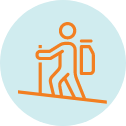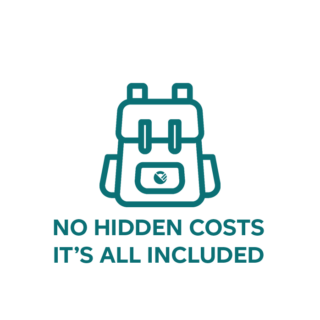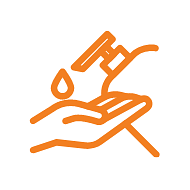Our Kilimanjaro expedition is meticulously designed for safety, unforgettable experiences, and personal transformation. Drawing from over a hundred successful climbs, we've curated every aspect of this climb, including a nutritious food menu to enhance acclimatization, regular health checks to keep track of your progress and clean private camping facilities including our own toilets to maintain personal hygiene. Our expert LHO Team Leaders collaborate closely with our local guides and porters to prioritize your safety and ensure you return with the cherished memories of a life-changing journey.

TRIP TYPE
Trekking, Summit

DURATION
9 Days

DESTINATION
Tanzania
1
Led by our expert LHO Team Leaders with years of high-altitude experience.
2
Meals are carefully curated and deliciously prepared by our LHO-trained Chef.
3
100% safety record on all our Kilimanjaro expeditions.






WHAT'S INCLUDED IN THIS TRIP
WHAT'S NOT INCLUDED IN THIS TRIP
DAY 1: JAMBO KILIMANJARO!
Upon your arrival at Kilimanjaro International Airport, you’ll be met by a member of the LHO team who will personally pick you up and transfer you in our private shuttle to the Grand Meliá 5* Hotel in Arusha. Your LHO Team Leader will be at the hotel to greet you. Once you’ve settled in, your gear will be checked to ensure you have everything you need.
On your first night, we’ll gather for a team briefing and dinner at a trendy Arusha restaurant. Sometimes our dinners are hosted at our hotel if we feel that it would give everyone more time to prepare their belongings and get enough rest for the adventure ahead of us. This will be your first chance to meet fellow participants and your lead local guides. It’s also an opportunity to learn about the exciting experience we’ve prepared for you and ask any questions you may have.
DAY 2: THROUGH THE TOWERING RAINFOREST
Distance: 10 KM | Ascent: 1220 M | Descent: 22 M | Max Altitude: 2,835 M
Our first day on the trail begins after breakfast and hotel checkout. We’ll head to the Machame gate by a private shuttle, about an hour’s drive away, where we’ll complete check-in procedures. Checking into Kilimanjaro Park can take around one hour. During this time, we’ll serve a hot lunch at the gate while we prepare for the hike.
The initial part of the trail takes us through the lush rainforest, offering opportunities to spot wildlife, including monkeys. This section showcases the trail’s most beautiful flora, allowing plenty of time for photos. The trail challenge fluctuates between steeper inclines and milder ascents. Our LHO team will be helping you find a comfortable and sustainable pace to walk and enable you to get into the rhythm of Kilimanjaro. We anticipate reaching Machame Camp (3000 m), our home for the night, close to sunset, where a delicious dinner will be served.
For many of us, this may be our first time camping ever. Not to worry! We’ll give everyone a brief induction about campsite etiquette, how to use our private bathrooms, where to find things like tea and coffee or hot water for washing up, and what’s the best in-tent strategy to maximize sleeping comfort.
DAY 3: THE MOUNTAIN OPENS UP
Distance: 5 KM | Ascent: 865 M | Descent: 50 M | Max Altitude: 3,840 M
On our second day, we start early, with the aim of leaving the rainforest behind and entering the short grass vegetation zone. Our first morning on the mountain can sometimes feel a little overwhelming as we pack up, have breakfast, perform individual health checks, and head out for the first time. You’ll get the hang of it faster than you think, and your LHO Team Leader will be around to help you throughout.
Once we hit the trail, the landscape will transition gradually from jungle to alpine as we ascend to 3,900 meters. The vegetation will start to shrink in size, and the views beyond the mountain will start to open up to us. The feel of the trail is a stark contrast to our previous day. The mud of the rainforest is replaced by rocky terrain. The towering vegetation gives way to open views of the summit crater, Mount Meru, and beyond.
Shira camp, named after the now-collapsed Shira crater on which the camp is situated, is at 3,700 meters. We typically arrive just after midday and serve a hot lunch at the camp.
The afternoon offers relaxation and opportunities to capture stunning views of Mount Meru on the horizon. Dinner will also be enjoyed at Shira camp.
DAY 4: A TOWER OF LAVA
Distance: 10 KM | Ascent: 820 M | Descent: 680 M | Max Altitude: 4,600 M
This is one of the longer trekking days of our adventure and is designed specifically to enable us to acclimatize efficiently. We begin our day earlier than on previous days to get a head start on the rains that typically arrive at Lava Tower just after midday due to Kilimanjaro’s micro-climate.
On the way to Lava Tower, we’ll experience our first taste of high altitude, reaching nearly 4,600 meters before descending to Barranco at 3,900 meters. Opting for the high route to Barranco allows our bodies to acclimatize. This is our first full day on the trail, and we’ll enjoy a hot lunch in our common tent set up for us at Lava Tower by the LHO Team before descending to Barranco for a hot dinner.
The environment completely transforms as we ascend through the alpine desert with striking rock formations left over from the last eruption. On some days, we might even encounter snow on the trail. As we descend from the high point to Barranco camp, we’ll pass through the largest concentration of Dendrosenecio Kilimanjaro trees. These rare trees are found only on Kilimanjaro.
DAY 5: THE BARRANCO WALL
Distance: 4.2 KM | Ascent: 400 M | Descent: 350 M | Max Altitude: 4,200 M
The Barranco Wall is a 300-meter-high feature flanking our camp. From a distance, it may look like a challenging climb, but as we approach, the trail becomes clear. A short walk from the camp leads us to the ascent, making it one of the most thrilling days of the trek with numerous photo opportunities. Once we reach the top, a gradual trek on well-marked terrain follows.
We aim to reach Karanga camp in time for a hot lunch, and the remainder of the day is dedicated to rest and acclimatization before dinner in the evening. Resting at Karanga is very important because it is our last opportunity to fully recover our strength for the summit.
DAY 6: BASE CAMP TO THE SUMMIT
Distance: 3.7 KM | Ascent: 640 M | Descent: 25 M | Max Altitude: 4,550 M
This is the shortest day on the mountain. The walk to Barafu at 4,600 meters is both beautiful and brief, with the Kilimanjaro summit ridge clearly visible above us all day. Before heading out, we’ll perform our customary health check. This is the most important check because it will determine whether we are able to give you the green light to continue into the higher altitude environment. Your safety is the only record we care to keep at all times.
We approach this day with a focused mindset, mimicking our summit night walk. This means short breaks and a slow yet steady pace. Upon reaching Barafu, we’ll have lunch and get the full summit briefing. The rest of the afternoon is dedicated to much-needed rest.
Dinner will be served earlier than usual to allow for enough sleeping time. We’ll be woken up from sleep around midnight to prepare for our ascent to the summit.
DAY 7: THE ROOF OF AFRICA
Distance: 16 KM | Ascent: 1250 M | Descent: 2800 M | Max Altitude: 5,895 M
We typically start walking between midnight and 1 am, depending on the overall pace of the group. Before moving, we’ll stock up on snacks and have the opportunity to eat some biscuits and drink hot tea.
The most challenging section of the trail is actually exiting Barafu camp. We are immediately confronted by a steep section that mirrors the rocky sections of our ascent to Shira camp on the second day of the trail. After about 30 minutes on the rocky section, the trail levels out as we approach an area called Kosovo. Once we cross the plateau, we’ll connect to the switchbacks, where we experience the most significant altitude gain. These switchbacks are the longest section of the trail and lead us to the crater ridge at Stella Point, from where Uhuru Peak comes into view. From Stella Point, it’s a relatively easy 40-minute ascent with the glaciers of Africa now flanking us on either side and the crater ridge visibly beneath us. On clear days, we can see the vast Savanna plains extending into Tanzania on our left and Kenya on our right. Your LHO Team Leader will be there to capture it all for you so that you can just focus on living these deeply transformative final steps to Uhuru Peak, the summit of Kilimanjaro.
After taking our summit photos and taking it all in, we’ll descend directly to Barafu, where we’ll rest for a couple of hours and have lunch. Following lunch, we’ll continue our descent to Mweika camp, located at the edge of the rainforest where oxygen is high, and the best sleep of your life awaits!
DAY 8: SHOWERS & FAREWELLS
Distance: 8.6 KM | Ascent: 0 M | Descent: 1444 M | Max Altitude: 2,800 M
The last morning is always bittersweet. On the one hand, we can’t wait to shower and reflect on the transformational journey we just shared. On the other hand, we are never really ready to say goodbye to the people who made it possible.
Before departing our camp for the final 3-hour trek to the gate, our LHO Team will treat us to the customary farewell party at the camp. Our team of porters, guides, chefs, and camp staff will give you a send-off like no other. This will be the last time you’ll see the full team and an opportunity to provide the team with a tip. Your LHO Team Leader will brief you privately on how we collect tips for this adventure.
After a full team photo, we’ll make our way down from Mweika, through the familiar rainforest, and finally to the gate of the national park.
Lunch will be served at the gate as our teams quickly perform the check-out procedures. Shortly after, we’ll be on our way to the hotel and the hot showers that we never take for granted ever again!
Our journey comes to an end with a team dinner hosted by your LHO Team Leader and the LHO guides.
DAY 9: HAKUNA MATATA RAFIKI!
The final day is dedicated to airport transfers. Breakfast is included at our hotel. Team members will be shuttled to the airport depending on flight times. Please be sure to communicate the correct flight times when you fill out your Team Details Form prior to this experience. Please make sure to communicate any changes to your LHO Team Leader as early as possible to ensure that arrangements are made.

OUR COMMITMENT
We are dedicated to ensuring that everyone involved in our services receives a fair living wage in their respective countries. We invest in our team members, fostering upward mobility within the adventure travel industry, expanding educational opportunities, and offering support wherever we can. By joining an LHO adventure you are directly impacting the incredible people and the remote communities that make these life-changing experiences possible.
LEARN MORE
HEALTH & SAFETY GUIDELINES
We do our best to ensure your wellbeing on LHO adventures. That's why the facilities we use throughout our trips are required to meet our health and safety standards. We also follow the laws and protocols of every country that hosts our adventures. This extends to national regulations requiring Covid-19 testing, vaccination certificates, mask wearing or any other local guidelines that may apply. Contact us for the most up to date protocols related to your destination.
LEARN MOREAre there any vaccines or medications I need to take for Tanzania?
What's the toilet situation?
Where does the drinking water come from?
What's the temperature and weather like?
How long does it take to climb Mount Kilimanjaro?
When is the best time to climb Kilimanjaro?
How hard is it to climb Kilimanjaro?
How to Prepare to Climb Kilimanjaro
Can a beginner Climb Kilimanjaro?
Do you need Oxygen to Climb Kilimanjaro?
What does it take to Climb Kilimanjaro?
PAYMENT PLANS AVAILABLE
FROM £0
DOWNLOAD YOUR TRIP GUIDEBOOK
INQUIRE NOW
This adventure is only available as a private trip and is customized to your requirements, experience and skill level. To get started, please fill out the form below. We’ll be in touch soon to put it together for you.
"(Required)" indicates required fields
CONTACT US
We’re passionate about guiding you to epic adventures and beyond. If you have any questions at all, don’t hesitate to reach out. We’d love to hear from you.

